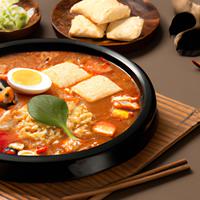
1 serving (500 grams) contains 600 calories, 25.0 grams of protein, 15.0 grams of fat, and 90.0 grams of carbohydrates.

Log this food in SnapCalorie

Nutrition Information
Calories |
288.0 | ||
|---|---|---|---|
% Daily Value* |
|||
| Total Fat | 7.2 g | 9% | |
| Saturated Fat | 1.4 g | 7% | |
| Polyunsaturated Fat | 0 g | ||
| Cholesterol | 24.0 mg | 8% | |
| Sodium | 1200.2 mg | 52% | |
| Total Carbohydrates | 43.2 g | 15% | |
| Dietary Fiber | 2.4 g | 8% | |
| Sugars | 3.8 g | ||
| protein | 12.0 g | 24% | |
| Vitamin D | 0 mcg | 0% | |
| Calcium | 48.0 mg | 3% | |
| Iron | 1.4 mg | 7% | |
| Potassium | 240.0 mg | 5% | |
* Percent Daily Values are based on a 2,000 calorie diet. Your daily values may be higher or lower depending on your calorie needs.
Food Attributes
Source of Calories
About Jjamppong noodles
Jjamppong noodles are a popular Korean-Chinese dish known for their bold, spicy flavor and comforting warmth. This noodle soup features a hearty combination of chewy wheat noodles, fresh vegetables like bok choy, carrots, and onions, and a medley of proteins, often including shrimp, squid, mussels, and pork. The soup base is made with a fiery red broth flavored by gochugaru (Korean chili flakes) and aromatic ingredients such as garlic and ginger, delivering a satisfying kick of heat. Jjamppong is nutrient-rich, offering low-fat proteins from the seafood and vitamins from the vegetables. However, it can be high in sodium due to the broth and seasoning, and the spice level may not suit all digestive systems. For a balanced meal, consider moderating portion sizes and pairing it with a lighter side dish. Jjamppong remains a comforting, flavorful treat that highlights the fusion of Korean and Chinese culinary traditions.



